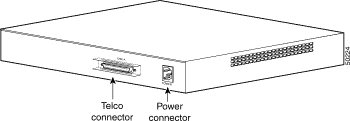|
|

The Cisco DPA 7630 and 7610 Voice Mail Gateways (DPA 7630/7610) enable you to integrate Cisco CallManager systems with Octel voice mail systems, which might also be connected to either Definity or Meridian 1 PBX systems. This integration enables you to use your existing third-party telephony systems along with your Cisco IP telephony system.
For example, you can ensure that features such as message waiting indicators (MWI) for Octel voice messages are properly set on Cisco IP Phones (connected to Cisco CallManager) as well as on traditional telephony phones (connected to Definity or Meridian 1 PBX systems).
Using the DPA 7630/7610, you can integrate the following systems:
These sections provide you with an overview of the DPA 7630/7610 and its interactions with the other components in traditional and IP telephony networks:
The Cisco DPA 7630/7610 enables you to integrate your existing Octel voice mail with Cisco CallManager and either a Definity PBX system or a Meridian 1 PBX system. If you have a Definity PBX, use the DPA 7630; if you have a Meridian 1 system, use the DPA 7610.
The DPA 7630/7610 functions as a gateway between the Octel, PBX systems, and Cisco CallManager, performing these tasks:
These sections provide additional detail about the interfaces and supported protocols on the DPA 7630/7610:
The wiring and external connectors of the DPA 7630 and the DPA 7610 differ slightly because the Definity system uses a 4-wire wiring scheme, and the Meridian 1 system uses a 2-wire wiring scheme.
The rear of the DPA 7630 (see Figure 1-1) includes the following interfaces:
The rear of the DPA 7610 (see Figure 1-2) includes the following interfaces:

The fronts of the DPA 7630 and DPA 7610 are identical (see Figure 1-3) and include the following interfaces:
The DPA 7630/7610 supports several industry-standard and Cisco networking protocols required for voice communication over an IP network. Additionally, the DPA 7630/7610 supports protocols required for remote network management.
The DPA 7630/7610 supports the following data and voice communication protocols.
The DPA 7630/7610 supports Simple Network Management Protocol (SNMP) and implements several industry-standard Management Information Bases (MIBs).
The DPA 7630/7610 (with software version 1.1 or higher) supports SNMP versions 1 and 2, enabling you to perform the following commands:
The DPA 7630/7610 supports the following MIBs:
RFC 1213 is the basic MIB 2 specification which indicates the state of network interfaces and statistics for network protocols.
The DPA 7630/7610 supports RFC 1213 on the Ethernet interface with the following caveats:
The DPA 7630/7610 implements the Ethernet Statistics group in Remote Network Monitoring (RMON), with the exception of "EtherStatsStatus." This is fixed at "valid" and cannot be written.
Cisco Discovery Protocol (CDP) is a method that Cisco devices use to advertise their presence and to discover information about other nearby devices. The DPA 7630/7610 implements all objects in this MIB with the exception of "cdpGlobalRun." This object returns "true" when read, and cannot be written using SNMP.
This MIB describes the processes currently running on the device. However, because the DPA 7630/7610 has threads, rather than processes, running on it the MIB is implemented with the following caveats:
The DPA 7630/7610 supports an additional DPA-specific Cisco MIB in version 1.2(1) and later. The MIB OID is: CALISTA-DPA-MIB.
For an explanation of this MIB, refer to the SNMP v2 MIBs available at the following location:
http://www.cisco.com/public/sw-center/netmgmt/cmtk/mibs.shtml
The DPA 7630/7610 functions by emulating digital phone or PBX systems. This capability allows it to appear like these devices to Cisco CallManager, Octel, Definity, and Meridian 1 systems.
These sections provide an understanding of the purpose of the DPA 7630/7610:
If you want to migrate your telephony system from a Definity G3 PBX or a Meridian 1 PBX to Cisco CallManager, you must decide whether to do a complete cutover to Cisco CallManager or to migrate slowly. If you do a complete cutover to Cisco CallManager and Cisco's voice mail solution, you do not need the DPA 7630/7610. However, if you are slowly migrating your systems, you might want to maintain some phones on the Definity or Meridian 1 PBX while installing new phones on the Cisco CallManager system. You might want to use your existing Octel voice mail system with your Cisco CallManager system. In these cases, the DPA 7630/7610 can assist your migration to Cisco CallManager.
One difficulty with migration is that voice mail systems such as Octel were designed to integrate to only one PBX at a time. To resolve this difficulty, many people use Simplified Message Desk Interface (SMDI), which was designed to enable integrated voice mail services to multiple clients.
However, to use SMDI, your voice mail system must meet several qualifications:
Additionally, SMDI requires reconfiguration of your existing telephony network.
SMDI might not be an option for you, particularly if you are using a digital interface on your Octel systems. Octel systems with digital line cards emulate digital phones, appearing to the PBX as digital extensions, referred to as per-port or PBX integration cards (PIC). On PIC systems, the voice and data streams (for setting MWI) are on the same path. The MWIs are set and cleared via feature access codes on dedicated ports. Because these PIC ports use proprietary interfaces, you cannot use standard interfaces to connect them to the Cisco CallManager system. However, the DPA 7630/7610 can translate these interfaces to enable communication between the Cisco CallManager, Octel, and Meridian 1 or Definity systems.
![]()
![]()
![]()
![]()
![]()
![]()
![]()
![]()
Posted: Wed Aug 14 10:16:42 PDT 2002
All contents are Copyright © 1992--2002 Cisco Systems, Inc. All rights reserved.
Important Notices and Privacy Statement.